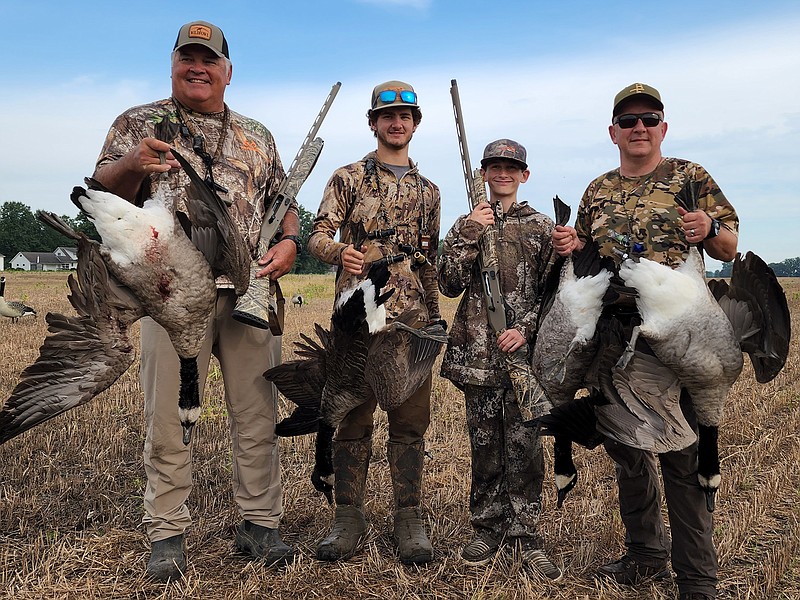I glanced over at Big Jim McConville and thought he looked like a coiled spring (albeit a really big coiled spring). We were both crouched in a brushy ditch with water above our ankles (this level changed later). Jim had a M3500 Stoeger shotgun clamped in his big mitts, and he was working his goose call profusely: E-yonk! E-Yonk! Yonk, yonk, yonk!
His plaintive calls must have sounded good to the gang of Canada geese about 400 yards out, because they turned slightly and came in our direction.
"They turned! Get down!" somebody to my left hissed.
It seemed a given that we all should do that, but we obeyed.
Now the geese were close, and you could hear the soft chatter in the flock. The tension of the eight or so gunners in our waterlogged blind was palpable, and you could almost hear it crackle like static electricity up and down the ditch. Hold, hold, I told myself; wait for the call from the guide to stand and shoot.
"Take 'em!" Brayden Cole yelled.
We rose as one, the Stoeger shotguns roared and geese fell from the heavy Ohio sky.
"This," I mumbled to no one particular, "is goose huntin'!"
This little party all started with a call asking if I would like to join an early season goose expedition to northern Ohio, right on Lake Erie. Our hosts were Keith Heinlein, product manager with Stoeger Industries, and Christian Hogg, director of marketing and new product development at Fiocchi Ammunition, along with McConville, who is a national sales manager for the Outdoor Sportsman Group, which comprises many outdoors and shooting-related publications.
McConville has lived in this area all of his life and is an avid sportsman, pursuing waterfowl, hunting those big Ohio deer and fishing on Lake Erie. He played college football at Ohio State and is big enough to eat hay with a personality to match. Everyone had a good time around Big Jim. He was perfect for showing our little band around the farms and fields near Avon Lake. (I'm not sure, but I think he knows everyone in the state of Ohio, if not the entire country.)
The Canada goose population in Ohio, and specifically around the shores of Lake Erie, has been an increasing problem since the 1960s. The sudden increase in their population has led to such problems as degraded water quality, agricultural damage and property damage. According to the Ohio State University College of Agriculture, hunting is the single best strategy for eliminating the problems caused by these geese while still having a healthy, controlled population.
Resident geese — that is, geese that seem to stay in the same area and don't migrate — can really add to the problem. If these Canada geese find enough food, water and roosting places in the area, they are likely to never leave. These resident geese will nest and raise new geese every year, and the population continues to grow. Where possible, sport hunting for the surplus geese is the best method to deal with the surplus population.
That is what we were here for: to experience an early season hunt and maybe whittle down the number of geese.
Waterfowl hunting (we had a little dove shooting on this trip as well) requires a good shotgun, and we were well equipped with the Stoeger scatterguns. The M3500 Stoeger has been around a few years and has a well-established reputation as a workhorse. It's an inertia-powered semiautomatic shotgun, which means it can go a long time without cleaning (unlike a gas gun) and will stand up to the abuse a duck hunter or goose hunter will dish out. As I have written in this space before, no shotgun is exposed to as much mud, water, ice and Labrador retriever slobber as a waterfowl gun.
The Stoeger M3500 Waterfowl Model has a 28-inch barrel. The receiver and barrel are finished in Cerakote Flat Dark Earth (this thin-film ceramic is practically indestructible), and the stock and forearm are Realtree Max-5 camo. This shotgun shoots 2 3/4-inch, 3-inch, and 3 1/2-inch shells. Maybe best of all, the M3500 won't break your bank. The manufacturer's suggested retail price is $849.
Those of you who hunt ducks and geese know the ammo you use is as important as the shotgun. Fiocchi Ammunition makes a wide array of shotgun shells (as well as pistol, centerfire and rimfire ammo), and on this trip we used Fiocchi Golden Waterfowl Bismuth shotshells. Waterfowl hunters also know bismuth shot is much more dense than steel, about 24% more, and is also nontoxic, so it meets the federal requirements for shot used for waterfowl.
In a nutshell, bismuth has better terminal performance (it kills cleaner) and is not as expensive as the next step up the pellet material ladder, which would be tungsten.
The loads we used were 12-gauge, 3-inch, 1 3/8 oz. of No. 4 shot. With a muzzle velocity of 1,450 feet per second, that is a screamer, and these shells performed well. I watched other members of the party crumple geese at the outer limits of shotgun range. If you are unfamiliar with Fiocchi, you may want to check up on them a bit. You may be surprised to learn that Fiocchi has been making ammunition right here in America — in Ozark, Missouri, since the 1980s, and now at an additional plant in Little Rock, Arkansas.
You can bet your boots I will be back in the northern part of the Buckeye State on the trail of the wild goose. All of that flat ground seems to appeal to me more these days, and I wouldn't mind a bit to watch Big Jim call in some more Canada honkers.
"Guns & Cornbread" is written by Larry Case, who lives in Fayette County, W.Va. You can write to him at larryocase@gmail.com.
